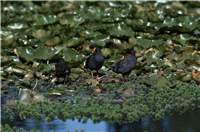Family
Rallidae
Genus
Gallinula
Species
tenebrosa
Threats/Control Methods - Regional
This species is threatened by the diversion of water away from naturally flowing rivers and wetlands into irrigation and human use, and the declining water quality from stock grazing and industrial run-off.
Threats/Control Methods - Local
Water bodies in urban areas are less resilient against periods of droughts or extreme weather events, causing a build-up of toxins and dangerous algae levels, which may impact the health of this species. This species relies on a range of healthy water species for feeding and is therefore impacted if water sources become polluted. The abundant Purple Swamphen (Porphyrio porphyrio ) is the major predator of their young.
Local/Urban Actions
There are many simple precautions residents can take to ensure waterways remain unpolluted. Joining in with a local Waterwatch activity can help improve water quality. At home, it is important avoid chemicals, pet faeces or garden waste going down the stormwater drain. Keep gutters clean and call the Canberra Connect helpline on (02) 6207 9777 for specific chemical waste disposal information. Dog walkers should keep pets on a lead and to collect all faeces and dispose of it in rubbish bins.
Common Names
Dusky Moorhen, Black Gallinule, Black Moorhen, Waterhen
Distinguishing Features
This bird is distinguished by its bright red head plate and bill, tipped with yellow. It is medium sized at 35-40cm and has large, strong looking legs and feet, coloured orange, yellow and olive green. Its plumage is dark slate grey with a white rump. Non-breeding birds may have a paler colour. Young birds are duller and lack a developed head shield.
Survey Techniques
Call and visual identification.
Species Call
A loud 'kerk!' and harsh repeated shrieks.
Similar Species
The Purple Swamphen (Porphyrio porphyrio ) is a larger and more boldly coloured bird of similar shape, with large red head shield.
Distribution
The Dusky Moorhen can be found across all of Australia's eastern states, in the east of SA and in the southwest tip of WA. There are also common in Borneo, Indonesia and New Guinea.
Country of Origin
Australia
Conservation (Pet/Pest) Status - Regional
The birds are fairly common across this region of Australia. However, in regional parts of NSW they have been recognised as a significantly declining species in response to water being pumped out of the natural waterways for irrigation.
Conservation (Pet/Pest) Status - National
Secure, not listed under the EPBC Act 1999.
LSCCES Population
Many birds were sighted at the NMA, with others at ANU, Turner and Civic West.
Associated vegetation community
This species inhabits a variety of wetland areas, preferring open, shallow waters surrounded by thick vegetation, including swamps, estuaries and lakes.
Limiting Resources
The Dusky Moorhen requires thick reed clumps on which to build platforms and nests. Dence trees along waterways provide necessary shelter, ideally free from predator species, especially when the young are dependant.
Breeding
During the breeding season, three males form a group to protect and mate with one female. The breeding season takes place from September to December. The nest is a bulky bowl of sticks, stems and bark, built in thick reeds or other wetland vegetation. They usually lay 6-9 oval, sandy-coloured blotchy eggs. Birds take extreme caution caring for their young, however many of the chicks do not survive their first year.
Behaviour
The birds spend time in loose flocks, except for in the breeding season, when they form small communal breeding groups. They can be seen feeding in shallow water, feeding on food at the surface or plunging their heads down for deeper vegetation. They are quick runners and swimmers, often dashing for cover. While swimming, they bob their heads back and forth, flicking their tails.
Functional Group
Food Species
The Dusky Moorhens will mainly eat the seeds and shoots of aquatic plants, some small invertebrates and seeds.
Predators
The young are most at risk from Water Black Rats (Rattus Rattus), Silver Gulls (Larus novaehollandiae ) and Swamp Harriers (Circus aeruginosus). Purple Swamphens (Porphyrio porphyrio ) may take eggs.
Interesting Fact
Dusky Moorhens build several nesting platforms during the breeding season, one concealing the one true nest and using the others as 'playgrounds' for their young.
References - (reader suitability of references, P=Primary teachers, S=Secondary students, T=Tertiary students and researchers)
Books:Morcombe, M. 2000. Field Guide to Australian Birds. Steve Parish Publishing. Archerfield. Australia P, S, T
Pringle, J. 1985. The Waterbirds of Australia. Angus and Robertson/National Photographic Index of Australian Wildlife, Sydney. S, T
Internet: Birds in Backyards. 2006. [online]. Available at:http://www.birdsinbackyards.net P, S, T
Canberra Ornithological Group (COG). 2004. Birds of Canberra Gardens. COG and the ACT Department of Urban Services. [online]. Available at:http://garden.canberrabirds.org.au/ P, S, T
Online Publications:ACT Government. 2006. Information Sheet: Stormwater Pollution from Residential Areas. Environment ACT. [online]. Available at: http://www.environment.act.gov.au/__data/assets/pdf_file/13168/Stormwater_Pollution_from_Residential_Areas.pdf P, S, T
Nix, H. and Cunningham, R. 2006. Birds of the Lower Sullivans Creek Catchment, Canberra ACT. Prepared for the Life in the Suburbs project using data from the Lower Sullivans Creek Catchment Ecological Survey (LSCCES). Australian National University. Canberra. [online]. Available at: http://www.lifeinthesuburbs.com.au/category.php?id=65 S, T
Olsen, P. and Weston, M. 2004. The State of Australian Birds 2004: Water Wetlands and Birds. Birds Australia. [online] Available at: http://www.environment.gov.au/biodiversity/publications/birds-04/regional.html S, T

 Top
Top Top
Top